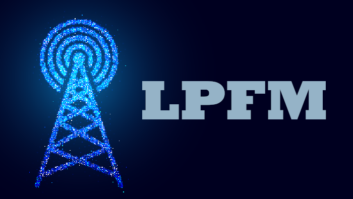A current Radio World ebook provides resources for the new generation of low-power FM radio stations now coming on the air in the United States. This interview is an excerpt.
Aqua Broadcast is a manufacturer of FM transmitters, amplifiers and audio processors. Brendan Lofty is business development manager.
RW: How can a new station get on the air affordably?

Lofty: LPFM is rewarding, but cost concerns often loom large. With careful planning and strategic choices, launching your station begins by researching equipment options from trusted suppliers and manufacturers. Transmitters, antennas and studio gear vary in price, but try to understand your local radio market, your budget and your future when making these choices.
Buy equipment, including a transmitter, that is as power-efficient as possible. Energy costs keep going up and are an important consideration. Calculate your overall energy costs and match that with equipment that maximizes consumption and eco credentials.
Your station will be around for many years, so a high-quality antenna is also important. You will need EAS and studio equipment. Also ask your equipment dealer about finance options tailored to LPFM.
RW: How can stations maximize the reach of their signal?
Lofty: Use the services of an experienced engineering consultant to design the system that maximizes your signal potential. The right antenna is pivotal.
Choose a site that will maximize your signal within the allowances of your license. Your consultant will work with your team and make sure that compliance with FCC regulations from a technical stance. Don’t forget to utilize a specialist attorney with whom you can work from the legal point of view.
Keep cable lengths as short as possible and make sure you maximize your total power output within the regulations. Choose a transmitter that offers multiple types of audio inputs, to capitalize on the several ways of getting audio to the transmitter site. And make sure your modulation level is correct.
Radio World: Describe the products you offer that are relevant to low-power FM stations.
Brendan Lofty: Our corporate planning made sure the Cobalt FM transmitter is the right transmitter for the LPFM in the United States. In early 2023 we heard there was going to be a new filing window, and the formal announcement came earlier than we had expected. Teaming up with our partners at SCMS, we positioned our products for the American market with promotions and stocks. SCMS offers the Cobalt transmitters for all user types, as well as LPFM-specific product bundles covering the transmission chain.
Cobalt earned a Radio World “Best of Show” Award at this year’s NAB Show.
RW: Are there common mistakes or misconceptions you’d like to see dispelled?
Lofty: Only FCC-certified transmitters are allowed for LPFM use. These transmitters will have an FCC ID label. Don’t be fooled by terms like “type accepted,” “type approved” or “type verified.” A Supplier’s Declaration of Conformity is also insufficient.
Our Cobalt transmitters, from 10 watts to 1 kW, are FCC-certified for LPFM use under Part 73 regulations, ensuring you are prepared for any future power adjustments by the FCC. This means they have undergone independent laboratory testing and meet strict FCC regulations.
While transmitters without the FCC ID label might be suitable for other broadcast services like full-service FM, they cannot be used legally in LPFM.
[REC Networks maintains a list of certified LPFM transmitters.]
RW: What technical tips can you offer a manager or engineer to help get the most out of their equipment purchase?
Lofty: Think ahead. How will your station’s content needs evolve? For example we offer multiple ways to stream audio to your transmitter, with options including Dante, MicroMPX or an IP codec. This flexibility ensures you can adapt to new formats and delivery methods that you may want now or in coming years.
IT security is important for all broadcasters, so our transmitters come equipped with HTTPS and secure email protocols. SNMP v1, v2c and v3 protocols provide advanced control and monitoring capabilities.
Other useful features of our transmitters are a built-in audio processor to optimize your sound; remote access with status alarms and notifications, so you stay informed and in control; and silence detection with audio failover.
RW: Is there a station among your clients that you feel embodies the best of LPFM?
Lofty: Kool FM 101.5 and 107.7 in Greenville, S.C. is WRTH(LP) and W299BO. It is not only operated by modern engineering personalities but also programming minds. Longtime programmer/engineer Dave Solomon built the station with both mindsets.
As a classic hits station, WRTH has top-notch Tony Griffin jingles, hourly national news, local news in drive times, market TV station weather, local announcers and a full serving of weekend syndicated shows. They also boast about being all-digital due to upgraded AES/EBU studios and the digital MPX and digital exciter in their new Aqua Broadcast transmitter. Dave told us the fringe signal noise is practically gone, which is important as WRTH is flanked by two co-channel FM translators, a new co-channel LPFM and two first-adjacent stations.
“At only 25 watts ERP, we want to do everything we can to deliver as much signal to the audience as possible,” Dave said.
Celebrating a decade on the air in July, WRTH continues to provide a top-shelf service at every stage of delivery to its audience. The staff also serve LPFM radio, working as advocates for other licensees, both with the FCC and at the station construction and operating level.






